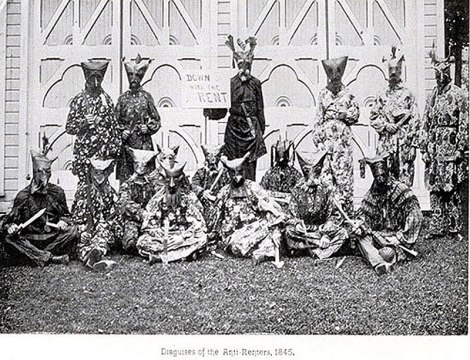AMERICAN MASQUERADE presented four gallery and museum exhibitions, 3 flashmob street performances, and a masked Baroque opera complementing free community workshops, performances, lectures, film screenings and concerts, engaging rural residents with over 100 artists, dancers, writers, historians, street performers, and musicians in exploring the role of masquerade in social transformations that shaped early American identity and history.
THE CALICO INDIAN DANCE SHOWDOWN
invited residents to step into history by participating in an interactive celebration of the Anti-Rent Wars. In this rebellion, the Calico Indians (disguised tenant farmers) were pitted against the land owning aristocracy, an important part of early Hudson Valley /Catskills history that ended feudalism in America. Three community performances took place in Catskill, Tannersville and Prattsville, NY, led by choreographer, Todd Whitley.
The Zadock Pratt Museum’s Anti-Rent War exhibition, Memorial Day – Columbus Day 2015 in Prattsville, NY.

Thomas Locker, Calico Riders In The Moonlight, Oil On Canvas, 20” X 65”, 1992. Work to be displayed at Zadock Pratt Museum’s Anti Rent Wars exhibition.
The Zadock Pratt Museum’s Anti-Rent Wars exhibition interprets the region’s 1840’s “Calico Indians” rebellion of tenant farmers, which overthrew feudal landownership. Rebels in calico dresses and sheepskin masks are portrayed by Catskill painter Thomas Locker (1937-2012), alongside costumes, documents, posters, and artifacts including tin horns used to rally the troops. Connections with recent movements for economic justice are made through maps. and a wrap-around, room-sized timeline. Algonquin scholar Evan Pritchard’s lecture will explore the farmers’ appropriation of Native American ideas, masks and materials. A gallery soundtrack includes recordings by contemporary and historic musicians inspired by the Anti-Rent Wars and economic protest movements past and present.
Their flag put it simply “DOWN WITH THE RENT”. Some Anti-Renters contested the idea that the Livingstons, Van Rensselaers and other patroons had legal title to the land. Some wanted to apply the rent paid toward ownership. Some just wanted the opportunity to buy the land where their families had lived since arriving in the new world. There were Anti- Rent flags, rallies, drinking songs, newspapers and political candidates. They organized into regional groups, with younger men joining a Calico Indian “tribe”, pledging a secret oath to never reveal the members’ identities. Disguised in calico costumes and sheepskin masks, the farmers called from valley to valley using tin dinner horns to rally the troops and intimidate the rent collectors.
Handel’s Masked Opera
Acis and Galatea
at the Catskill Mountain Foundation
The Catskill Mountain Foundation presented a performance of the Baroque Opera, “Acis and Galatea” by Handel, performed by harpsichordist Andrew Appel and the Four Nations Ensemble, with masks by Joyce Kozloff. “Acis and Galatea” was written as a courtly entertainment, and is considered to be the pinnacle of pastoral opera. The opera adds a European historical context to AMERICAN MASQUERADE, connecting U.S. festivals, such as New Orleans’ Mardi Gras, begun in 1703, with Colonial masquerade dances, Baroque operas and festivals. Colonial American masked celebrations drew on European traditions and set the stage for events like the “Calico Indians”. The CMF Gallery plans a gallery exhibition of contemporary mask makers’ work with selections from collections that draw from worldwide folk traditions.
-

Leafman , leather mask by Wendy Drolma in the
Catskill Mountain Foundation’s exhibition of
contemporary sculptural masks. - The Catskill Mountain Foundation also hosted a screening of Bruce Kennedy’s documentary film on the Anti Rent Wars and an Old Songs festival with storytelling and drinking songs composed by the creative farmers of the Anti-Rent movement.
- The Prattsville Art Center curated three exhibits of work created by visiting artists and local communities in workshops including Native American Traditions by artist and American Indian scholar Tlisza Jaurique, Michael Adno’s installation investigating the Anti Rent Wars murder of Osmon Steele and an annual Halloween exhibit by artists in residence and community members.

Tlisza Jaurique




